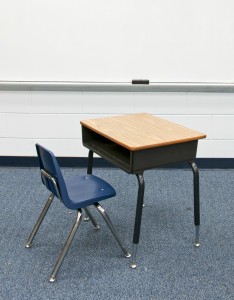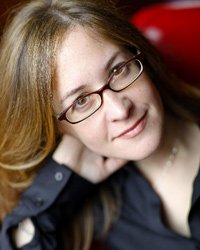It’s a defining moment for the educational sector. With the start of the new school year, there is perhaps no better time to discuss some critical issues facing the educational sector.
For one thing, for the first time in history, U.S public schools will welcome back a new majority – a student body of black, Latino, Asian, and Native American children who now make up more of the student population than non-hispanic whites. Many of these students fall below the poverty line and fall behind in schools adopting tough new academic standards.
What’s more, Standard and Poor economists recently released a new analysis that called education inequality the main barrier to the country’s economic recovery – declaring that if the average American worker finished just one more year of school the U.S. economy would grow $105 billion annually for the next five years.
To discuss the changing face of public education and what is being done to ensure equity, SEE Change editor-in-chief, Elisa Birnbaum, spoke with Dan Cardinali, president of Communities In Schools. For over thirty years the organization has been helping students achieve in school, graduate and go on to bright futures. Believing that relationships have invaluable impact, Communities in Schools embraces an evidence-based model that positions site coordinators inside schools to assess students’ needs and provide resources to help them succeed in the classroom and in life.
Please comment on the recent Standard and Poor declaration that education inequality is the main barrier to the country’s economic recovery. How have you experienced that challenge in your work and how concerning is it to you?
This is an issue that we talk about all the time at the leadership level of Communities In Schools. In fact our board chair, Elaine Wynn, just published an op-ed on the topic at FoxNews.com, so it’s really top of mind for us. There’s no doubt that the wealth gap in this country is getting out of control. Education should be our best tool for combating the trend, but instead we’re allowing the wealth gap to create an education gap, because so many poor kids are concentrated in under-resourced schools where they simply don’t have the same opportunities as their more affluent peers.
How does the new demographic of students (“the new majority”) and rising levels of poverty impact the challenges ahead for those working in the field of education?
Let me address the poverty issue specifically, because it affects all kids in similar ways – whether poor white kids in Appalachia or poor black kids in South Chicago. Poverty creates a whole constellation of problems that makes it harder for students to be truly present and available for learning. In poor neighborhoods, hunger and hopelessness and fear are a part of life, and kids can’t just check their problems at the door of the school. Maybe a girl can’t see the board because her family can’t afford to buy glasses, or maybe a boy is sitting in math class knowing that his mother is being evicted from their temporary housing. How are kids supposed to learn in those conditions?
Briefly describe the community school model – when it originated, its mission and how it works
Community schools seek to erase the artificial lines that separate the school from the broader community. The model recognizes that we can’t treat “failing schools” as a freestanding problem, separate from other community issues such as unemployment, homelessness and crime. When everyone “owns” the problems of failing schools and high dropout rates, then we can begin to think holistically about the best way to address those issues. Government, businesses, churches, nonprofits – everyone has a stake in education, and everyone has something to offer. Community schools are about joining hands instead of pointing fingers.
Tell us about the work of Communities In Schools, its mission, the challenges it faces and what you’re doing to overcome them
We recognize that every community has an incredible wealth of resources available for struggling students, but all too often those resources go untapped simply because of the “silos” that separate education from other public and private sectors. At Communities In Schools, we put a trained site coordinator inside a struggling school, tasked with identifying at-risk students, befriending them, and connecting them to the resources they need to stay in school and succeed in life. We call this Integrated Student Supports because we’re finding resources for the students and delivering those supports in the school setting, where we can be most effective and efficient. It might be transportation or mentoring or eyeglasses or daycare – the needs are as varied as the students themselves – but it takes a caring, trained adult to identify both the problem and the solution.
The challenge, I suppose, is that our model is labor intensive. You can’t build relationships with a mail survey or a smartphone app. You have to be there every day in the school and out in the community. Over the past 30-plus years, we’ve developed a set of best practices for the effective delivery of Integrated Student Supports. Today we’re providing integrated student supports directly to more than 1.2 million students, but we know that only scratches the surface. In order to quickly ramp up the human resources needed to reach another 5 million needy students, we’re exploring a kind of accreditation program that would allow other organizations to learn the finer points of integrated student supports. If we can’t personally reach every student who needs help, we at least want to ensure that every student has access to a quality, accredited ISS provider committed to evidence-based results.
Please explain why you believe the debate vs public/charter schools or vouchers should not be our focus and why servicing underprivileged kids should be.
There is no question that we should have an honest dialogue about how we can ensure that all children – particularly those from disadvantaged backgrounds – have access to good schools in their community. The truth is that if we want students to succeed in good schools and benefit from education reform initiatives, we have to address the environmental issues that are barriers to learning. If a child is hungry, homeless, cold or lacks a caring adult in their life, it has a profound negative impact on their ability to learn. So must our attention on kids to ensure they are ready to learn in the classroom. Until we do that, we cannot change the picture of education for millions of children.
Elisa Birnbaum is the co-founder, publisher and editor-in-chief of SEE Change Magazine, and works as a freelance journalist, producer and communications consultant. She is also the president of Elle Communications.


